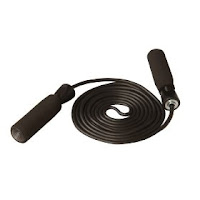 Miss Mary Mack, Mack, Mack; All dressed in black, black, black…word, you know how it goes. That’s right, bought a jump rope today, ready to get my hops on. An eight dollar investment, and a little time to pick up the skill (I’ve never jumped rope before…Lame-O), and I should be cutting up in no time.
Miss Mary Mack, Mack, Mack; All dressed in black, black, black…word, you know how it goes. That’s right, bought a jump rope today, ready to get my hops on. An eight dollar investment, and a little time to pick up the skill (I’ve never jumped rope before…Lame-O), and I should be cutting up in no time.
Why jump rope? Best cardiovascular workout you can get, and I’m all about endurance and stamina these days. My plan is four times per week, ten minutes, that’s all…very doable.
Float like a butterfly…
Jumping rope not only gives an arse-kicking cardio workout, it works the legs and abs too. Further, the bouncing motion is in sync with the vibratory oscillations of our cells, atoms and subatomic particles. I, therefore, am going to oscillate.
Flying high now…
I bought a light-weight speed rope. Eight bucks and change at Sports Chalet. Much cheaper than a trampoline, although I’m thinking about one of those too. So, I start this week–anyone else with me?












